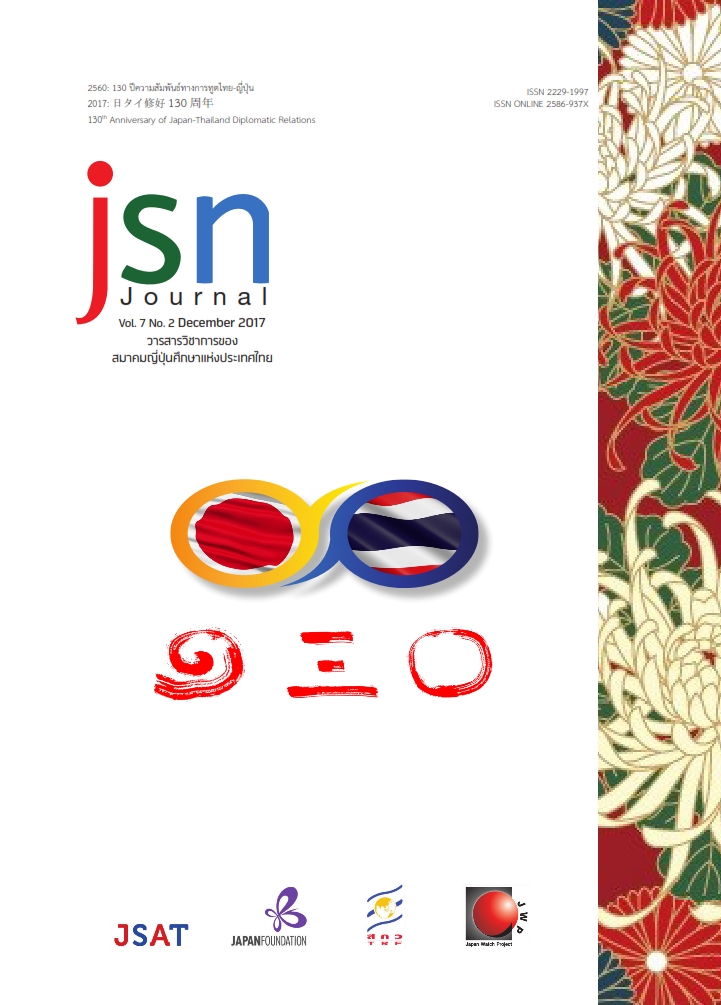Social role of the Toshiyori, enforcers of ceremonies, in the middle Edo period: Analysis of the festival of Ta’asobi
Main Article Content
Abstract
The purpose of this paper is to clarify the social role of the Toshiyori in the middle Edo period. Until now, Japanese history studies have maintained that the social role of a Toshiyori, who was a village chief in the pre-Edo era, was limited to one of ceremony by the Nanushi, who was designated the new village chief in the Edo era. However, conducting festivals and performing rituals were closely related to the social class
of a village. In other words, a Toshiyori as the ceremonial enforcer had social power. This research focuses on the Ta’asobi festival in the Tokumaru Village, analyzed it using the concepts of historical studies and
folklore studies, and showing the social role of a Toshiyori. This paper uses historical documents from the house of Yasui, who was a Nanushi of Tokumaru Village during the Edo period. Social role of the Toshiyori, enforcers of ceremonies, in the middle Edo period: Analysis of the festival of Ta’asobi.
Article Details
ข้อความและข้อคิดเห็นต่างๆ ในบทความเป็นของผู้เขียนบทความนั้นๆ ไม่ใช่ความเห็นของกองบรรณาธิการหรือของวารสาร jsn Journal
References
安藤精一.(1960). 『近世宮座の史的研究』. 東京:吉川弘文館.
新井恒易.(1970). 『中世芸能の研究』. 東京:新読書社.
エドワード .P.トムスン (E.P. Thompson). (1982). 「ラフミュージック」 二宮宏之 ・ 樺山紘一・福井憲彦(編).『魔女とシャリヴァリ』(79-138).東京:新評論.
藤木久志.(1998).『戦国の作法』.東京:平凡社 .(初出1987 年).
福田アジオ.(2000).「みやざ 宮座」『日本民俗大辞典』下. 東京:吉川弘文館.
井上智勝.(1997).「地域社会における吉田神道の受容-宗源宣旨の授受を中心に」 『日本史研究』416: 48-66.
________. (2007). 『近世の神社と朝廷権威』. 東京:吉川弘文館.
板橋区立郷土資料館編.(1997). 『田遊び:農耕文化と芸能の世界』.東京:板橋区 立郷土資料館.
勝俣鎮夫.(1996).『戦国時代論』.東京:岩波書店.
大林太良.(1992).『正月の来た道』.東京:小学館.
折口信夫.(1995).「田遊び祭りの概念」『折口信夫全集 3』.東京:中央公論社. (初出 (1929). 『民俗芸術』2 (9) )
澤登寛聡.(2000).「割本制と郷村の自治秩序―寛文・元禄期の武蔵国多摩郡三田領吉野 家の管轄地域を素材として―」『法政史学』54 : 1-47.
________.(2010)『江戸時代自治文化史論―一揆・祭礼の集合心性と地域・国制の秩序』. 東京:法政大学出版局.
諏訪春雄.(1994 a). 『日中比較芸能史』.東京:吉川弘文館.
________. (1994 b).「日中稲作芸能の比較」諏訪春雄・川村湊 (編),『アジア稲作民の 民俗と芸能』(133-156).東京:雄山閣.
薗部寿樹.(1993).「中世村落の諸段階と身分」『歴史学研究』651: 73-82.
________. (2002).『日本中世村落内身分の研究』.東京:校倉書房.
________. (2017).「中世村落史研究と信仰・儀礼―歴史学と民俗学のはざまから― 」 『山形県立米沢女子短期大学生活文化研究所報告』44 : 25-38.
高橋統一.(1978).『宮座の構造と変化―祭祀長老制の社会人類学的研究』.東京:未来社.
高牧実. (1986).『宮座と村落の史的研究』.東京:吉川弘文館.
竹田聴洲. (1977).『村落同族祭祀の研究』.東京:吉川弘文館.
萩原龍夫. (1962).『中世祭祀組織の研究』.東京:吉川弘文館.
原田敏明. (1967).『村祭りと座』.東京:中央公論社.
肥後和男. (1970).『宮座の研究』.東京:弘文堂.
フレイザー.J. G. (2004). 『金枝篇』<第一巻:呪術と王の起源(上)> (The Golden Bough) (神成利男 訳).東京:国書刊行会. (原著1906年)
本田安次. (1967).『田楽・風流1』 . 東京:木耳社.
水本邦彦. (1987).『近世の村社会と国家』.東京:東京大学出版会.
________. (1993).『近世の郷村自治と行政』.東京:東京大学出版会.
宮原浩. (1998). 「幕末期徳丸本村の年中行事 」『板橋区立郷土資料館紀要』12: 29-45.
森岡清美.(1954).「村落の階級構造と宮座」『社会科学論集:東京教育大学文学部紀要』1: 110-161.
Radcliffe-Brown, A. R. (1952). Structure and function in primitive society, essays and addresses; London: Cohen & West.
イヴ=マリ・ベルセ(Yves Marie Berce). (1980).『祭りと叛乱―16~18世紀の民衆意 識―』(井上幸治監訳).東京:新評論.
和歌森太郎.(1953).「宮座の解消過程―奥能登の頭屋制を中心として―」 『日本民俗学』1(2) : 1-17.
若曽根了太「江戸時代前・中期の入会地と地域秩序:武蔵国豊島郡峡田領「赤塚郷 六か村」の自治と徳丸原をめぐって 」『法政史学』60 : 82-102.


